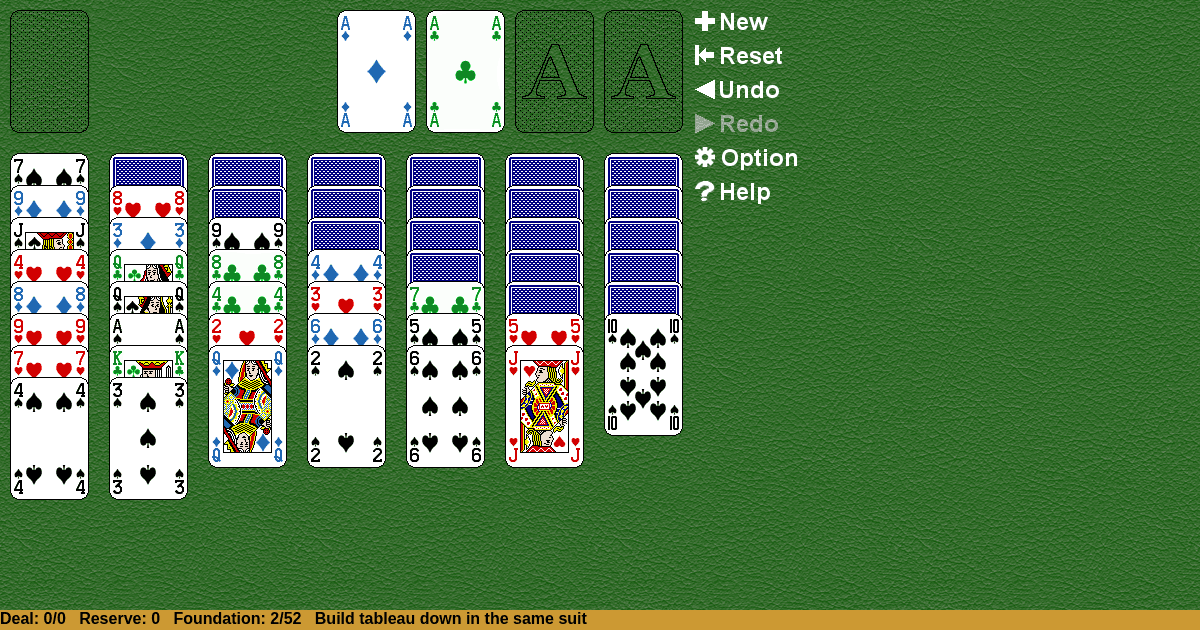Dragon
Home |
How to play |
FAQ |
About
How to play Dragon?
Game Objective:
The primary goal in Dragon Solitaire is to move all cards from the tableau and reserve to the foundation piles, building each foundation in ascending order by suit from Ace to King.
Setup & Layout:
- Deck: Uses a standard 52-card deck.
- Tableau: 7 tableau columns are created:
- The first 3 columns each have 8 face-up cards.
- The next 4 columns each have 7 face-up cards.
- All cards in the tableau are dealt face-up.
- Foundations: 4 foundation piles, initially empty, positioned above the tableau.
- Reserve/Stock: Any remaining cards (if applicable) are placed in a reserve or stock pile, though most implementations deal all 52 cards into the tableau at the start.
- Key Play Areas:
- Tableau: Main play area where cards are moved and sequences are built.
- Foundations: Destination piles for each suit, built from Ace to King.
- Reserve/Stock: Used in some variants to deal new cards onto tableau piles.
Dragon Solitaire Rules:
- Building on Tableau:
- Cards are built down in rank and by the same suit (e.g., 10♠, 9♠, 8♠).
- Only cards of the same suit and one rank lower may be placed on a tableau pile’s top card.
- Sequences of cards in correct order and suit may be moved together as a unit.
- Moving Cards:
- Only face-up cards not covered by other cards (i.e., the top card or a valid sequence) may be moved.
- Any card or valid sequence can be moved to another tableau column if it fits the building rule.
- Foundations:
- Foundations are built up in rank and by suit (e.g., Ace♣, 2♣, 3♣, …, King♣).
- Only Aces can be placed on empty foundation piles.
- Cards cannot be removed from the foundation once placed.
- Empty Tableau Columns:
- Any card (or valid sequence) may be moved to an empty tableau column.
- Reserve/Stock (if present):
- In variants with a reserve, pressing the reserve button deals one card onto each tableau pile.
Gameplay:
- Sequence of Play:
- Move cards within the tableau, following the building rules, to uncover and access other cards.
- Move eligible cards to the foundation piles as soon as possible.
- Use empty tableau spaces strategically to rearrange sequences and access buried cards.
- If a reserve or stock exists, deal new cards onto each tableau pile when no other moves are possible.
- No More Moves:
- If no legal moves are available and all reserve/stock cards have been dealt (if present), the game ends.
Winning & Losing Conditions:
- Winning: The player wins by successfully moving all cards to the four foundation piles, completing each suit from Ace to King.
- Losing/Unwinnable: The game is lost or becomes unwinnable if there are no legal moves left and not all cards have been placed in the foundations.
Special Rules & Edge Cases:
- Filling Empty Tableau Columns: Any card or valid sequence may be placed into an empty tableau column.
- Moving Sequences: You may move a group of cards in correct descending order and suit as a unit between tableau piles.
- Reserve/Stock Use: In variants with a reserve, each activation deals one card to each tableau pile, and this can only be done when all tableau piles are occupied.
- Foundation Rules: Once a card is placed in the foundation, it cannot be moved back to the tableau.
- Edge Cases: If all tableau columns are empty except one, you may continue moving sequences as long as the building rules are followed. If an Ace is not exposed, you cannot start a new foundation for its suit.
Note: There are multiple variants called "Dragon Solitaire." This guide is based on the most widely referenced rulesets for the classic single-deck version inspired by Chinese Solitaire and Scorpion. If you are playing a digital or themed version, consult the in-game help for variant-specific mechanics.

Solitaire Collection
About Dragon
Rate (Dragon)
4.7 / 5
1,916 votes



























































